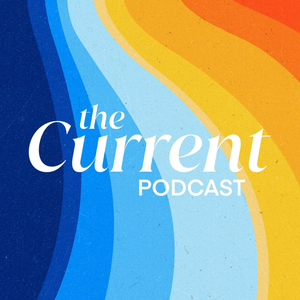
The Current Podcast
The Current
All episodes
Best episodes
Seasons
Top 10 The Current Podcast Episodes
Goodpods has curated a list of the 10 best The Current Podcast episodes, ranked by the number of listens and likes each episode have garnered from our listeners. If you are listening to The Current Podcast for the first time, there's no better place to start than with one of these standout episodes. If you are a fan of the show, vote for your favorite The Current Podcast episode by adding your comments to the episode page.
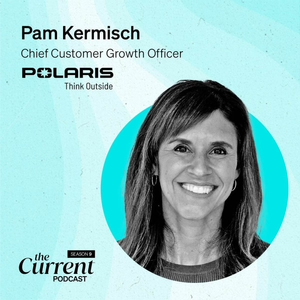
Polaris’ Pam Kermisch on marketing past assumptions in the powersports space
The Current Podcast
07/03/24 • 22 min
Polaris’ Chief Customer Growth Officer talks with The Current Podcast about how many of the company’s customers are multicultural and have preferred style over performance.
Episode Transcript
Please note, this transcript may contain minor inconsistencies compared to the episode audio.
[00:00:59] Damian: I'm [00:01:00] Damian Fowler.
[00:01:05] Ilyse: And I'm Ilyse Liffreing. And
[00:01:07] Damian: welcome to this edition of The Current Podcast.
[00:01:09] Ilyse: This week, we're delighted to talk with Pam Kermisch, the Chief Customer Growth Officer at Polaris.
[00:01:15] Damian: Polaris was founded 70 years ago with the invention of the early snowmobile in 1954. Polaris takes its name after the North Star, and it's meant to reflect the location of the company's first headquarters in northern Minnesota.
[00:01:34] Ilyse: These days, Polaris is the global industry leader in power sports. Offering everything from Indian motorcycles to its off road racers. And all the accessories that go with them.
[00:01:44] Damian: During the pandemic, the brands saw a surge of interest in its vehicles as people embraced outdoor activity. Although it started out as a specialized brand, it continues to build on its popularity through its marketing campaign. Think outside.
[00:02:03] Pam: Back in 1954, two brothers and a best friend decided they way, faster to get to their location. And they literally strapped a motor to the back of a sled and created the first snowmobile. It was ingenuity at its best.
[00:02:20] And when I think about Polaris today, We have recreational vehicles. We have motorcycles. We have off road vehicles. We have boats. We also have utility vehicles that help people do work smarter. And at the end of the day, it's really about getting people outside and helping to have a better way to do things, whether it's working smarter or on the recreational side, having the most epic experiences with your friends and family.
[00:02:47] Ilyse: Very nice. Now in 2019, the brand actually underwent a new rebranding with a new Think Outside campaign.
[00:02:56] Ilyse: I read that there is a goal to basically grow the base [00:03:00] by 50 percent by tapping into your existing base and finding new customers as well. What was your strategy around that and how has it played out to this point?
[00:03:11] Pam: Yes. So in 2019, We really took a look at talking to our existing customers, talking to potential intenders of our brands and talking to people we thought might be interested in what we offer. And we did some great consumer research. And what we learned is at the heart of it, we tapped into what they really care about.
[00:03:35] And what we found is what our current existing owners care about. More people could care about. We just had to find the right people. We had to reach out to them. We had to show them how this could fit into their lives and introduce them to our brand. And it's really been a huge effort the past few years. To find the right people and show them how this could fit in with what they already do and make it better. And on top of bringing in more new customers, it's also bringing in new people that look a little different than our core customers.
[00:04:11] Damian: Very interesting, because when you think what sell in a way, kind of very specialized, I don't know whether I'd it niche.
[00:04:22] Pam: you know, I think when you look at household penetration off road vehicles, for example, household - So you're right. It's not something where it's 70, 80, 90 percent of the market has one of these. But what I will say is if you think about some of the audiences. We do attract people love outdoor recreation. love being outside. They love adventure. They might do camping, they might do hiking, they might do fishing. We also think about the people who do property maintenance They're farmers, they're ranchers, They're hunters. So, when you think about those populations, they are much more likely to buy our products. But if you look at the penetration even within those, We don't have 80 90 percent of hunters, so there's still so much penetration opportunity within people who do the activities where it seems like they would really benefit from something that we could offer them.
[00:05:26] Damian: Was there a moment when you realized there was the potential to expand the audience? That's so interesting to me and I wonder how you found that opportunity.
[00:05:40] Pam: So I'm kind of a nerd, self admittedly kind of a nerd. And I really think that CRM and data and analytics played a huge role in this journe...
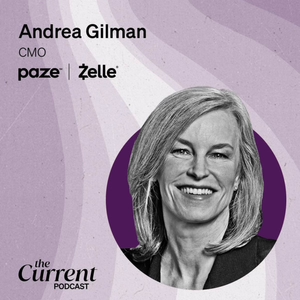
Paze and Zelle’s Andrea Gilman on the future of digital payments
The Current Podcast
03/31/25 • 24 min
At SXSW, The Current Podcast partnered with The Female Quotient to spotlight trailblazing women in media and marketing to mark International Women’s Day and Women’s History Month.
In this episode, we sit down with Andrea Gilman, chief marketing officer at Early Warning, owner of digital payments services Paze and Zelle, to discuss how she’s driving innovation in digital payments.
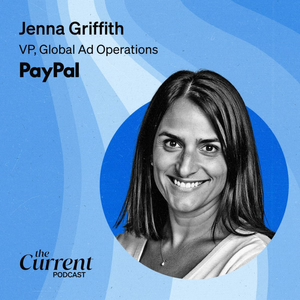
PayPal’s Jenna Griffith on building a media business from transaction data
The Current Podcast
05/14/25 • 22 min
Jenna Griffith, VP of global ad operations at PayPal, shares how the fintech giant is using shopper insights to power a new kind of media network.
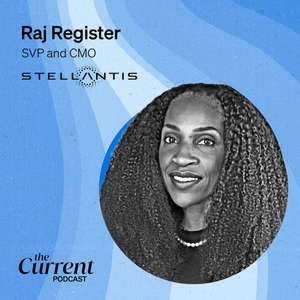
Stellantis’ CMO Raj Register on knowing your brand’s true north
The Current Podcast
04/09/25 • 27 min
Stellantis’ CMO Raj Register talks about building consistent storytelling across channels, what she’s learning from AI and why she’s obsessed with connecting marketing action to tangible business outcomes.
Episode Transcript
Please note, this transcript may contain minor inconsistencies compared to the episode audio.
Damian Fowler (00:00):
I'm Damian Fowler.
Ilyse Liffreing (00:01):
And I'm Ilyse Liffreing.
Damian Fowler (00:02):
And welcome to this edition of The Current Podcast.
Ilyse Liffreing (00:09):
This week we're delighted to talk with Raj Register, the Senior Vice President and CMO for North America at Stellantis, one of the biggest names in the global auto industry.
Damian Fowler (00:19):
That's right. Stellantis is the powerhouse behind iconic brands like Jeep, Dodge, Ram, Chrysler, and so many more.
Ilyse Liffreing (00:26):
And as our North American fans may be well aware, stellantis just ran off one but two high profile spots at the Super Bowl in February, both featuring major celebs,
Damian Fowler (00:37):
Glenn Powell as Goldlock in the Ram Super Bowl commercial, and Harrison Ford who rarely appears in ads starring in the Jeep commercial.
Ilyse Liffreing (00:45):
Let's get started.
Damian Fowler (00:51):
The first thing I want to ask you, Raj, is how did it all come together?
Raj Register (00:55):
Yeah, that's a great question and not the most straightforward way that many would think. So at Stellantis we have something called a jump ball. And Jump ball basically means that we curate several agencies and we allow them to pitch and based on the pitch how we brief them and whoever comes up with the best idea pretty much wins the business. So for this past Super Bowl, we spoke to around 35 plus agencies and we were able to round them out to the best two, one for Ram, one for Jeep. So we go through several rounds of creative, we determine what's the best story, how does it really relate to our business? And from my perspective it was what's the best creative outside of that? Then what's the best thing that will help give us more runway past the Super Bowl? So outside of the creative is the business aspect and how are we going to perform and make sure that it delivers upon all of our goals.
Damian Fowler (01:56):
Now everyone knows, I guess at this point that the Super Bowl ad spot is one of the most coveted in the world and one of the most pricey I suppose. But wanted to ask you why was it important for Stellantis? I mean, you're the only order maker as I understand it, to have a spot during the game this year. Why was it important for you?
Raj Register (02:14):
There's a lot of dialogue around why were we the only one. I saw it as an incredible opportunity for us to be auto exclusive. When do you get to do that? During Super Bowl? It was really important for us to show up, not only to show that we're here, not only are we American born and we are proud of our brands, but when we think of everything we have to offer to our consumers, we wanted to leverage this as an opportunity to tell that story and give them an indication of who we are. And it was almost like a reintroduction back to America as well as supporting our UAW workers, supporting our dealers, supporting our employees. So I think it was a rally cry for us to just let ...
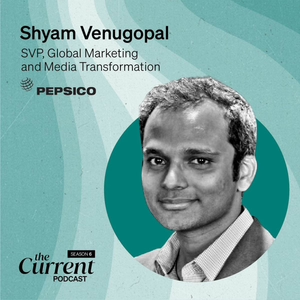
PepsiCo SVP Shyam Venugopal on the importance of simple human insights
The Current Podcast
08/09/23 • 21 min
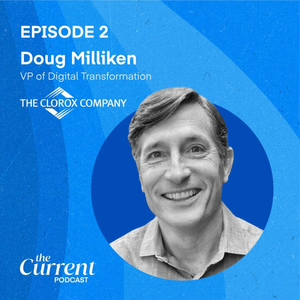
Clorox’s Doug Milliken on continuing ad spend despite economic uncertainty
The Current Podcast
09/22/21 • 21 min
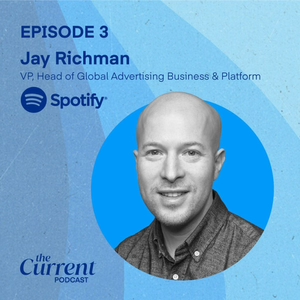
Spotify VP Jay Richman on why the company is betting big on podcasts
The Current Podcast
09/29/21 • 21 min
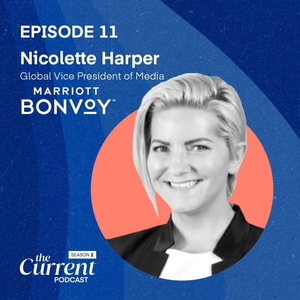
Marriott’s Nicolette Harper on how the brand built up consumer confidence during the pandemic
The Current Podcast
02/09/22 • 20 min
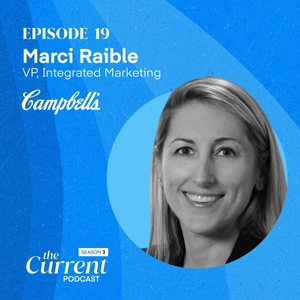
Campbell’s Marci Raible on why ‘Not all data is created equal'
The Current Podcast
08/03/22 • 19 min
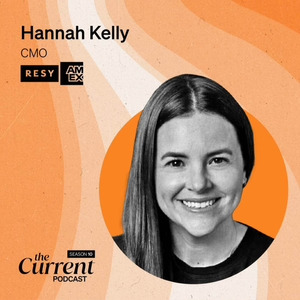
Resy’s Hannah Kelly on building community and connection
The Current Podcast
10/16/24 • 20 min
The reservation platform Resy centers itself around the communal experience that comes from dining, affirming and building connection between restaurants and diners, according to CMO Hannah Kelly.
Episode Transcript
Please note, this transcript may contain minor inconsistencies compared to the episode audio.
[00:00:00] Damian: I'm Damian Fowler.
[00:00:01] Ilyse: And I'm Ilyse Liffreing
[00:00:02] Damian: welcome to this edition of The Current Podcast.
[00:00:05] Ilyse: This week, we're delighted to talk with Hannah Kelly, the CMO of Resy.
[00:00:09] Damian: Want to make a restaurant reservation? American Express owned Resy is there for you. With over 40 million global users, the app has driven over 600 million reservations. Now that's a lot of fine dining, I imagine.
[00:00:23] Ilyse: With almost 14 years of working at American Express under her belt, Hannah leads marketing efforts to connect restaurants and tastemakers.
[00:00:31] Damian: We start off by talking about the value of customer data and how insights inform Resy's marketing strategy.
[00:00:38] Damian: We work in an industry where, data is capital. You know, how does Resy rely on the customer data, especially from its parent company, American Express?
[00:00:47] Hannah: Sure. So thank you so much for having me. And you could argue that the premise of the Resyacquisition was based on American Express's deep use of data. So when we look at spend at American Express, dining one [00:01:00] of our highest spend categories. We reached 100 billion in spend for the full year in 2023 for the first time ever.
[00:01:06] So for us, being an American Express and in the business of membership, we are constantly looking for ways to engage and attract card members and deepen our relationships with merchants. Resy naturally presented that opportunity as a way for us to own an asset, own a brand, and build a community of being able to connect the world's best restaurants to the world's best diners on a proprietary basis.
[00:01:28] Damian: That makes a lot of sense. I, as an Amex owner, do spend a lot in restaurants. I wonder if you have any interesting stories around turning those insights into action.
[00:01:38] Hannah: Sure. So, We know that millennials and Gen Z's are worried about making the perfect reservation. In fact, we commissioned our own research and we found that 50 percent of the millennial and Gen Z population are worried about making the perfect reservation.
[00:01:52] And so with that, that drove three sort of primary objectives and campaigns for us. So first is our brand platform. we launched a brand platform in [00:02:00] 2023 called Reservationships, which is really meant to highlight how that Resy is more than reservations, really being that trusted partner in crime when you don't know where to go.
[00:02:09] You want to have that fine dining moment with your potential in laws to be with a new date. How can we really own the fact that Resy has served as that sort of curator, and role. I think the second piece has been, this past year we introduced our Resy shareable hit list. so what that function allows you to do in the iOS app is anyone can go in and create a list based on any title that you want.
[00:02:31] Go to date nights. Kid friendly places. You name it. We have some very creative takes in there. and you can share them out with friends. So again, it's really meant to give users the confidence that they are selecting and making the best reservation possible for them.
[00:02:48] Hannah: And we've extended that and really leaned into that a bit more with our third deliverable this year, which has been around the launch of our discover tab.
[00:02:54] So now when you go into the Resy app, you not just only see a list of restaurants based [00:03:00] on your location or cities. We've always had collections, but now our discover tab actually brings in all of our editorial content into the app. And just for reference in Q one of 2024, we highlighted over 000 plus restaurants in all of our editorial across 300 stories.
[00:03:17] So now all of that content is there in formats that can helpfully guide users on how they can connect with restaurants that they should love if they don't know them already and ones that they want to continue to celebrate their love for and be a patron of.
[00:03:28] Ilyse: You know, retail data continues to have a moment among marketers. In your experience, how much do these insights influence your strategy? And what do you think is the future of this type of data?
[00:03:42] Hannah: So I think for us, guest research is the number one place that we constantly look to. And for us, a lot of that is where are people notifying, where are people searching, where are people dining. And at American Express, we're able to see where our car...
Show more best episodes

Show more best episodes
FAQ
How many episodes does The Current Podcast have?
The Current Podcast currently has 114 episodes available.
What topics does The Current Podcast cover?
The podcast is about Brand, Brand Building, Marketing, Media, Leadership, Cmo, Advertising, Podcasts, Ceo, Digital Marketing, Business, Tips, Trends, Careers and Growth Hacking.
What is the most popular episode on The Current Podcast?
The episode title 'On chocolate and politics: What CPG brands and political campaigns have in common' is the most popular.
What is the average episode length on The Current Podcast?
The average episode length on The Current Podcast is 21 minutes.
How often are episodes of The Current Podcast released?
Episodes of The Current Podcast are typically released every 7 days.
When was the first episode of The Current Podcast?
The first episode of The Current Podcast was released on Sep 15, 2021.
Show more FAQ

Show more FAQ